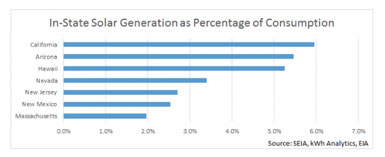In the first quarter of 2015, renewable energy provided 14.6% of electricity in the US, a level the US Energy Information Agency (EIA) forecast for 2040!
And in California, EIA announced utility-scale solar now provides 5% of the state’s electricity – a first for a state – but it left out the other half – rooftop solar.
That’s because EIA doesn’t count distributed solar, of which there is now 9.2 gigawatts on 700,000 rooftops – about 45% of US solar capacity, according to U.S. Solar Market Insight Q1 2015.
It doesn’t have the information on this mass of small systems, so the Solar Energy Industries Association (SEIA) has teamed with kWh Analytics to calculate that. Based on the data, actual solar production is 50% higher than EIA estimates, says Greentech Media.
Solar is supplying more than 5% of electricity in California, Arizona and Hawaii, and total US solar electricity generation exceeds the consumption of 16 states and the District of Columbia, they say.

Besides being vital for tracking the growth of solar in the US, accurate information is also used to evaluate how the solar tax credit (ITC) is performing and to set policies on the state and federal levels.
EIA has been taken to task over the past year or so for underestimating the amount of renewable energy generally in the US, and it underestimated the amount of natural gas recoverable in California by a whopping 96%!
Cheapest Solar Ever
Utilities are getting solar cheaper than ever when they issue RFPs, as we are seeing in Texas and Nevada.
In Texas, Austin Energy issued a RFP for 600 megawatts of solar, and besides received offers for 8 gigawatts, 1.3 GW of that came in below 4 cents per kilowatt-hour (kWh). That’s lower than last year’s landmark price at just under 5 cents.
In Nevada, NV Energy (now owned by Warren Buffet) got an even better deal at $0.0387 per kWh for buying energy from First Solar’s Playa Solar 2 project. That’s compared to $0.14 last year!
In fact, each time a RFP goes out, the prices are lower. The downside is that utilities may start holding back because prices could drop more if they wait.
Read our article, Which States Have the Cheapest Electricity? Those With the Most Renewable Energy.

